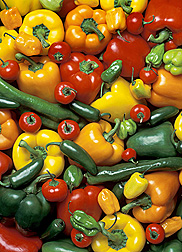|
|
New Hope for Extending Fresh-cut Vegetable Storage
By Sharon Durham
December 31, 2015
Fresh-cut peppers and lettuces in supermarkets have a shot at lasting longer thanks to U.S. Department of Agriculture (USDA) scientists in Beltsville, Maryland, and Salinas, California.
Agricultural Research Service (ARS) plant geneticist John Stommel and his research team with the Genetic Improvement of Fruits and Vegetables Laboratory, and food technologist Yaguang (Sunny) Luo with the Food Quality Laboratory, both in Beltsville, Maryland, evaluated a diverse collection of peppers for attributes that would prolong their shelf life after being cut.
The team looked at 50 types of peppers available commercially and from the ARS collection—sweet bell, large elongated peppers, jalapeno, and serrano—to find those that can stand up to prolonged cold storage. Fresh-cut sweet bell and elongated peppers exhibited signs of deterioration, such as fluid leakage, after 10 to 14 days of storage, whereas jalapeno and serrano peppers didn't lose fluids until 14 days of storage. Fluid leakage is undesirable as it causes peppers to lose firmness and marketability.
The team found that some varieties in each pepper type showed exceptional fluid maintenance beyond 14 days, meaning the peppers stayed firm and didn't exhibit tissue breakdown. The results provide opportunities for plant breeders, via traditional breeding, to incorporate attributes that contribute to fresh-cut quality into elite varieties that will benefit the food industry and consumers, according to Stommel.
The very action of cutting fresh produce results in damage to plant tissues, increases respiration, and shortens postharvest shelf life. The loss of fluid from tissues is closely related to the quality and shelf life of fresh-cut produce. Leakage is indicative of cell damage and is responsible for adverse changes in fresh-cut product color, texture, flavor and microbial growth.
Lettuces, the base of salads everywhere, are also targeted for improvement. Luo and plant geneticists Ryan Hayes and Ivan Simko at the ARS Crop Improvement and Protection Research Unit in Salinas, California, found several genetic markers that will allow lettuce breeders to confer a longer shelf life to salad-cut lettuce. Lettuce with a gene that results in rapid decay becomes unusable in one to two weeks, according to Hayes. In contrast, lettuce with a slow decay gene lasted one month or longer.
The research results from these evaluation studies will facilitate development of improved varieties that greatly benefit growers, packers, processors and consumers.
ARS is USDA's principal intramural scientific research agency.
Read more about this research in the December issue of AgResearch magazine.

